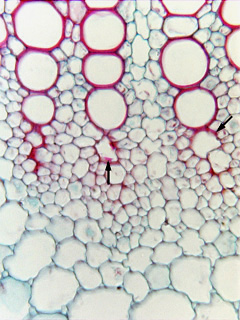 Fig.
7.5-5a.
Transverse section of vascular bundle in stem of ragweed (Ambrosia). The
narrowest vessel elements here (marked by arrows) are protoxylem. They stopped
enlarging and began depositing their secondary wall (in either an annular or
helical pattern) while they were still so young that they were very small. Once
mature, they digested away their protoplasts and died. But the surrounding cells
remained alive and growing, and because all the cells are glued together by
their middle lamellas, the growth of the living cells caused the dead protoxylem
elements to be stretched into larger and larger sizes. Finally, the
primary walls were stretched to their maximum and were torn apart, creating the
holes visible here. Once the primary walls ruptured, the vessel
elements were no longer able to conduct water. But by that time, other cells had
matured into newer, larger vessel elements and conduction in this part of the
stem was still possible.
Fig.
7.5-5a.
Transverse section of vascular bundle in stem of ragweed (Ambrosia). The
narrowest vessel elements here (marked by arrows) are protoxylem. They stopped
enlarging and began depositing their secondary wall (in either an annular or
helical pattern) while they were still so young that they were very small. Once
mature, they digested away their protoplasts and died. But the surrounding cells
remained alive and growing, and because all the cells are glued together by
their middle lamellas, the growth of the living cells caused the dead protoxylem
elements to be stretched into larger and larger sizes. Finally, the
primary walls were stretched to their maximum and were torn apart, creating the
holes visible here. Once the primary walls ruptured, the vessel
elements were no longer able to conduct water. But by that time, other cells had
matured into newer, larger vessel elements and conduction in this part of the
stem was still possible.